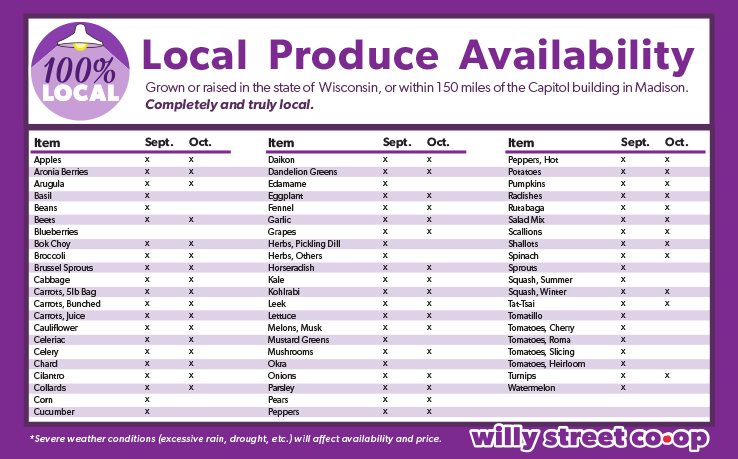by Andy Gricevich, Newsletter Writer
WHAT’S SEASONAL?
A rich forest odor of morels in May. The whole bag of Door County cherries eaten on a park bench as the midsummer day goes on and on. Ears of buttered corn, as often as possible, for a short, sweet month. Pure autumn in the scent of apples just picked. On a cold night, porter, rich and dark, while a roast cooks in its nest of potatoes and squash. Bright citrus in dark January. Waiting, waiting, for the first sweet overwintered spinach of spring.
Our economy trades a sense of natural time for the convenience of nearly unlimited availability. We often forget that anything has its season. Eating in sync with nature’s rhythms puts us, to some extent, back in touch with our fellow living creatures, with the earth and sky, with different kinds of time. It’s also easy, enlivening and fun. Seasonal eating isn’t an ideology. You don’t have to overhaul your life—but you can enrich it with a simple meal.
SEASONAL FLAVOR, SEASONAL MEDICINE
As any chef, gardener, or person over 70 knows, there’s a vast difference between fresh food grown in ideal conditions and product stored for weeks or months before being chilled, warmed, chilled, shipped across the country, chilled and finally put on the grocery store shelf. Some of the best foods can’t even survive storage and shipping, which is why you can’t get ramps or heirloom tomatoes in fall and winter, and why they’re so special when they arrive.
The sensual pleasures of flavor align with the millennia of evolution that have primed us for optimal health when we eat seasonally. The wellness-promoting compounds in plants and fungi, which have always been our primary medicines, work best if they have some time to accumulate in our bodies. Eating the same plant frequently for a while maximizes its benefits.
While we’re building up beneficial compounds, we’re also accumulating toxins. In fact, many nutrients can be considered toxic if they stick around for too long in our systems. When we switch foods with the seasons, we give our bodies the chance to cleanse themselves of whatever they’ve been building up. The fitness-food trend of “cleansing” is rooted in the natural purifications that come with a seasonal diet.
We’re also well-adapted to the specific kinds of foods that go with particular times of year. Winter brings slowness into the depths of our bodies; we do well with starchier vegetables, and with the healthy fats that come from fully-mature animals raised in their own natural conditions. Spring begins the acceleration of our metabolisms. We’re able to more efficiently digest raw foods, and we naturally tend toward a diet rich in purifying green plants. Summer berries help protect our skin and eyes from the intense sun.
Our needs vary with current environment and genetic lineage. What your ancestors ate for generation after generation probably affects what’s best for you. On the other hand, your present climate might call for foods and preparation techniques that would have made no sense to your forebears. You don’t necessarily have to think through all the complexities, though; seasonal eating is a great way to figure out which preparations of which foods leave you feeling at your best.
EATING OUT OF SEASON
Few of us want to discard the advantages of technologized civilization. Even so, it’s worth asking what it takes to supply us with a given food product year-round. Among multiple answers to this question, we can distinguish between innovative seasonal extension that works with natural conditions and, on the other hand, production that operates in spite of them.
By the early summer, the Co-op’s Produce department begins receiving delicious tomatoes grown here in Wisconsin. They’re raised at Shady Maple Acres by Jacob Lapp, an Amish organic farmer who grows them in covered hoop houses that hold in enough heat to produce ready-to-eat fruit in June, well before anything is ripe in the field. Tomatoes grown for shipping on the West coast seem like entirely different food by comparison.
Whether it’s artificial light to keep hens laying, hay for grass-fed animals, or trial plantings of early-bearing fruit, seasonal extension requires extra money, labor and resources. Nonetheless, it can be ecologically sustainable. Pushing the seasons challenges the imaginations of farmers and graziers dedicated to feeding their regional communities.
Much of our winter produce comes from Southern California, Arizona, and Baja Mexico (basically the same place, with the same ecology, work force, labor conditions and quality standards). Grown in desert landscapes made viable by massive irrigation projects, which deplete aquifers and drain rivers, these plants have to expend a great deal of energy to draw nutrients from the thin soil. Despite warm year-round weather, the lack of adequate sunlight in winter further weakens plants’ ability to make the compounds that repel pests and provide us with valuable micronutrients. Bugs move in, quality and nutrition go down, and a lot of food goes to waste.
Tradeoffs vary from crop to crop, from one location to another, and from one season to the next. Citrus, for example, becomes abundantly available from large and small growers in winter. If ecological and economic sustainability motivate us to eat seasonally, we can decide when it makes the most sense to expand our diet beyond our region.
HOW DO I START?
It’s easy! If you don’t know what’s in season, your Co-op’s Produce department staff are always happy to answer questions. The purple “locally grown” signs can also let you know what’s at its peak in our region. As far as produce from distant states and countries is concerned, you can usually tell its best time by higher quality and lower prices. You can also see a chart of current local availability on the next page of this issue.
It’s not much harder to eat in season than it is to grab the same things every time you buy groceries, and it’s generally less expensive, no matter where you shop. It does make it easier if you’re willing to try new foods. If you want some decisions made for you, sign up for a CSA (Community Supported Agriculture) share, and you’ll be met with fresh, varied produce every week from spring into the late fall.
Things start to get a little more challenging around November. Summer crops dwindle, and eventually the hardy greens fizzle out. By January or February, even winter squash starts to fade. If you’re really into eating with the seasons, you’ll likely be sick of cabbage and beets by the time spring comes—but here are some ideas for ways to keep meals interesting through the cold times:
Try braising, which involves cooking meats or vegetables in a little bit of liquid at low temperatures, often for a long time. Braised storage crops become meltingly sweet, and tough cuts of meat luscious and tender. It’s an easy way to make delicious, warming food.
Experiment with slaws. I love to mix grated celeriac, beets, and carrots with some lemon, mayo, salt and pepper, and parsley. I just keep changing up the vegetables over the course of the season. Many vegetables that are traditionally cooked can be eaten raw this way, and slaws make a accompaniment for meat and roasted or baked storage crops.
I make a lot of parsley-based salads during the winter. Though not in season or available locally then, parsley remains fresh, vibrant and healthy when kale has long since gone pale and wilted. I chop it up finely as a main ingredient, and add diced beets, carrots and radishes, dressing it simply with olive oil, salt, and a lot of lemon juice, or even whole chopped Meyer lemons. I also make any number of variations on citrus salad, dressed with a little oil, vinegar and herbs.
For breakfast, see how magical you can make hot cereal. Steel-cut oats, with their long cooking time, invite dried fruits and coconut oil, as well as cardamom pods and other spices. Toss in mixed nuts or pumpkin seeds at the end. This is where the Bulk department is your best friend. Add miso paste and other savory ingredients. Just scoop a little of something new into a jar and try it out!
I started learning to make good food at home with the aid of a number of cookbooks, and I still love many of the recipes I found there. When I started eating in season, though, I found that the ingredients I used required only the simplest preparations to end up as delicious, healthy meals. I was hooked for life.
PRESERVING TIME
Seasonality goes beyond the present. Traditionally, we’ve also prepared for the next season by putting up much of our current bounty. Preserving food is a great way to enjoy the flavors of spring, summer and fall during colder, darker times. Here are some good preservation techniques:
- Blanch or sautee greens and peppers and freeze them.
- Mix chopped herbs with softened butter and keep in the freezer.
- Can tomatoes and fruits as sauces and jams.
- Get into fermentation (the safest and most energy-efficient form of preservation).
Sandor Katz’s books are a great starting place for making krauts, kimchis and pickles easily with veggies and salt. You can also preserve garlic, berries and hot peppers in honey for immune-supporting tonics.
Preservation can be a beautiful aspect of seasonal eating. I love being able to bring the bounty of the growing season back into my diet during the winter. The flavors bring back memories, and make the year feel whole.
NATURE INSIDE US; FOOD AND MEMORY
Modern life can alienate us from natural rhythms. Most of our schedules don’t change much with the dwindling or increase of light and warmth throughout the year. Rather than living immersed in nature, we’re allowed to select what we want from it, and to block out what we don’t.
Eating is the direct transformation of another living body into the material of our own—an act of deepest intimacy. Seasonal eating can soften our separation from nature, linking us to the soil and sky, to sun and rain. Just as our bodies thrive when we live in relation to natural cycles, so our histories grow rich and deep.
A food eaten at its proper time can inscribe powerful memories to replay throughout life. Eating sweet corn, tomatoes and peaches, and a family dinner in the evening of an endless day comes back, bringing with it the feeling of the swim taken as the sun set, and the sweet safe sleep when you finally got to bed. A handful of ripe blackberries returns you to bramble-scratched skin at the edge of the woods, with close friends from school. You make the stew again you invented last winter, and the whole of that season wells up in you. Share any of these with the people present in your life now, and the kaleidoscope of lived time gains another facet.
Food makes strong memories, binding experiences together, filling any time in our lives with meaning, making it particular, letting it stand out. Those memories go beyond our individualities. They’re communal, multi-generational, ancestral—shared not only with the people we used to be, and with others we’ve known, but with everyone for whom the act of eating has been merged with a powerful sense of time and place. It may sound like poetic exaggeration, but, in a life that can so often seem a speeding blur or a monochromatic canvas, eating in season is among the activities that can return us, for a time, and for another time, and another, to the rich and vividly detailed life-experience that’s our human birthright.


